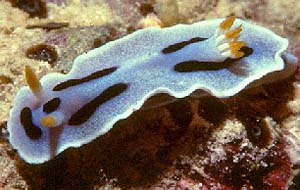
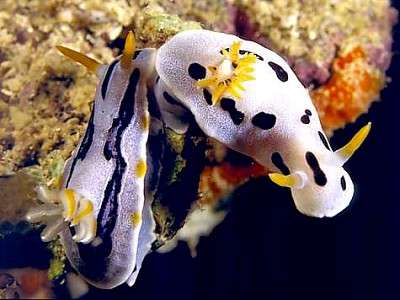
Chromodoris dianae
Gosliner & Behrens, 1998
Order: NUDIBRANCHIA
Suborder: DORIDINA
Family: Chromodorididae
DISTRIBUTION
Known only from Philippines, Indonesia and Borneo.
PHOTO
UPPER: Cebu, Philippines, November 1988. Photo: Ho Soon Lin.
LOWER: Showing both colour forms - Batangas, Philippines, this April, 1999. Photo: Jeff Rosenfeld
Reference:
• Gosliner, T.M. & Behrens, D.W. (1998). Five new species of Chromodoris (Mollusca: Nudibranchia: Chromodorididae) from the tropical Indo-West Pacific. Proceedings of the California Academy of Sciences, 50: 139-165.
Rudman, W.B., 1998 (April 8) Chromodoris dianae Gosliner & Behrens, 1998. [In] Sea Slug Forum. Australian Museum, Sydney. Available from http://www.seaslugforum.net/find/chrdian
Related messages
Chromodoris dianae feeding
August 1, 2007
From: Nerida Wilson
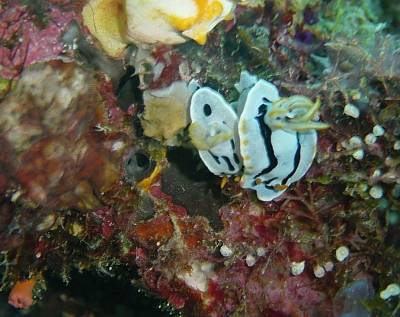
Concerning message #20016:
Hi everyone,
here's another photo of Chromodoris dianae feeding on an overgrown sponge.
Locality: Kaledupa, Tukangbesi Archipelago, 5m, SE Sulawesi, Indonesia, Indo-Pacific, 10th July 2002 , Reef wall. Photographer: Nerida Wilson.
Nerida Wilson
ngwilson@ucsd.edu
Wilson, N.G., 2007 (Aug 1) Chromodoris dianae feeding. [Message in] Sea Slug Forum. Australian Museum, Sydney. Available from http://www.seaslugforum.net/find/20330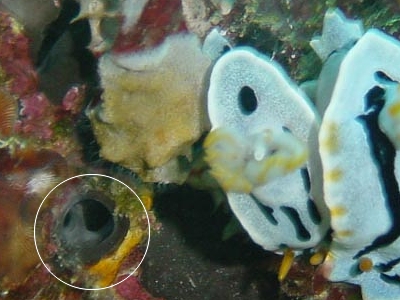
Dear Nerida,
Thanks for the photo. It again shows the trials of studying feeding in these animals. I suspect the sponge is a thorectid. The siphon I have ringed looks very like that of Semitaspongia sp. The two animals in your photo show some of the colour variability found in this species, one with orange around the mantle edge, one without.
Best wishes,
Bill Rudman
Chromodoris dianae with yellow spots
February 21, 2007
From: Roberto Sozzani
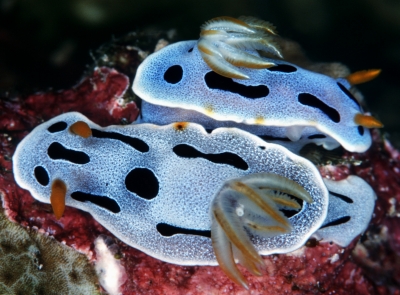
Dear Bill,
Reading the message #19390, I remembered a group of four chromodorids I photographed years ago in Manado. I didn't know it was a colour form of Chromodoris dianae before. I've never seen it again.
Locality: Manado, 26 metres, Infonesia, Pacific Ocean, June 2003, Sandy slope with corals. Length: 3 cm. Photographer: Roberto Sozzani.
Best wishes
Roberto Sozzani
www.robertosozzani.it
roberto.sozzani@fastwebnet.it
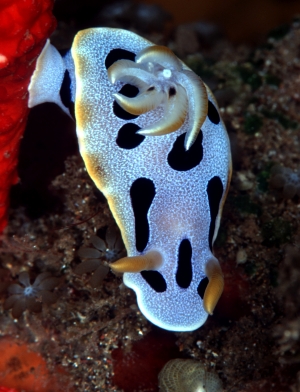
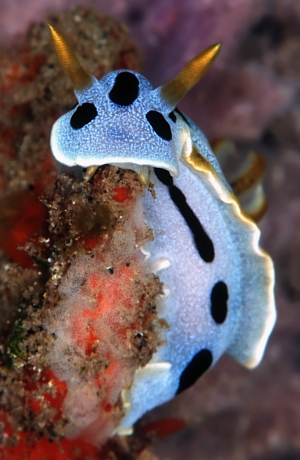
Dear Roberto,
Thanks for this nice set of photos which show the colour pattern of this form very well
Best wishes,
Bill Rudman
Re: Chromodoris willani & C. boucheti
February 21, 2007
From: Bob Whorton
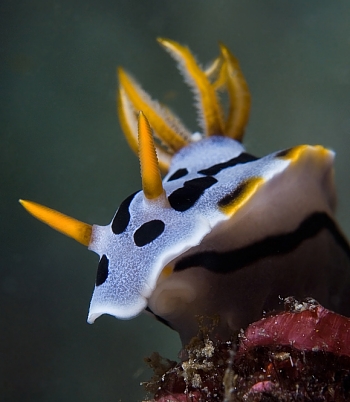
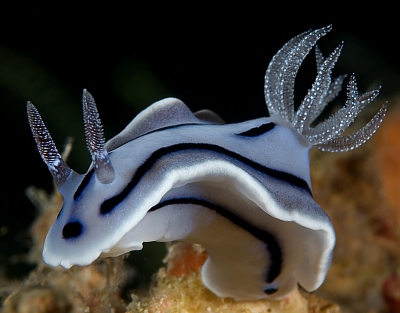
Concerning message #19444:
Hi Bill,
Thanks again for the ID info, the Chromodoris colour similarities between species is quite confusing. Something else I noticed is the difference in colour of the rhinophore on C. willani; blue/grey - red/orange as in the last batch.
I'm including a few more along the same lines to add to the debate of "It was white with black stripes"
Here are photos of C. lochi, C. dianae and an individual with yellow block mantle edging.
Locality: Halmahera/Raja Ampat, 12m, Indonesian , Halmahera Sea, July & December 2006, Typical sloping reef with coral outcrops. Length: 3 cm+. Photographer: Bob Whorton.
Bob Whorton
DrBob.Whorton@btinternet.com
Whorton, R., 2007 (Feb 21) Re: Chromodoris willani & C. boucheti. [Message in] Sea Slug Forum. Australian Museum, Sydney. Available from http://www.seaslugforum.net/find/19469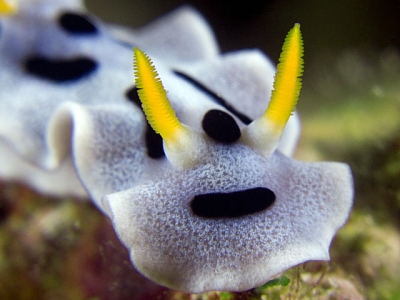
Dear Bob,
Thanks for the photos. The top one is the colour form of C. dianae in which the gills are orange-yellow rather than yellow-tipped. The middle one is C. willani, which is quite distinctive in having white spots on the gills and rhinophores, although the background colour can vary from greyish to pinkish. The photo alongside is also C. dianae, but in this case I suspect it is the one which has gills which are white in the lower half and yellow in the upper half.
I am not sure which one you thought was C. lochi, but that species differs in having translucent gills, which range from pinkish to yellowish in colour but lack white spots, and a greyish blue to white mantle which is a uniform colour, lacking any white spots.
Best wishes,
Bill Rudman
Chromodoris dianae from Malaysia
February 5, 2007
From: Mike Krampf
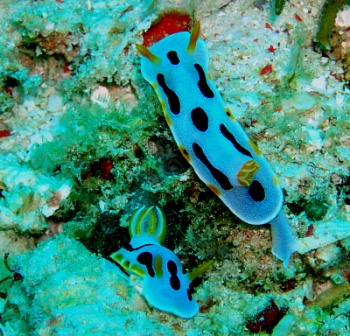
This one has me stumped as I haven't been able for find one that matches this color pattern. I'm guessing it's a Chromodoris sp but I haven't seen one before with the yellow spots and can't find it in my books or on the Forum. Can you help me ID this one?
Locality: Dive Site - Coral Garden off Mataking Besar Island, 60 Ft, Sabah, Malaysia, Celebes Sea, 03 February 2007, Fringing reef. Length: 3 cm. Photographer: Mike Krampf.
Thanks,
Mike
mtkrampf@yahoo.com
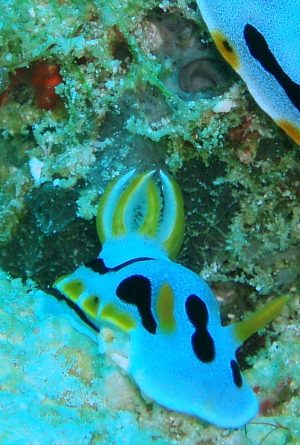
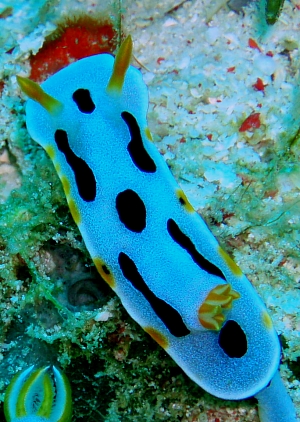
Dear Mike,
This is one of the colour forms of Chromodoris dianae. The other colour form has white gills with yellow tips. Interstingly we have a few records of that colour form feeding on a grey sponge Petrosaspongia [message #12000], and if you look at the lower left close-up you will see a similar sponge in the background which they may be eating. However just to make it difficult, there are another group of chromodorids with this black-lined pattern which feed on red sponges quite like the one being 'examined' by the bigger animal. So all I can say is that it is interesting to find these animals together near these sponges, but it may just be a coincidence.
Best wishes,
Bill Rudman
Chromodoris dianae from Nth Sulawesi
January 26, 2007
From: Mirjam Broos
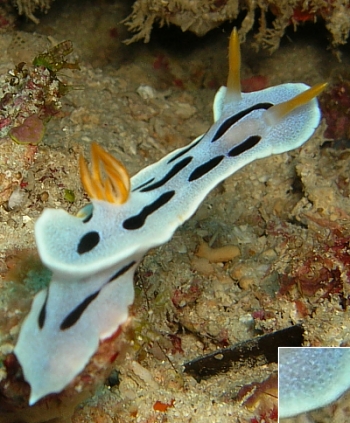
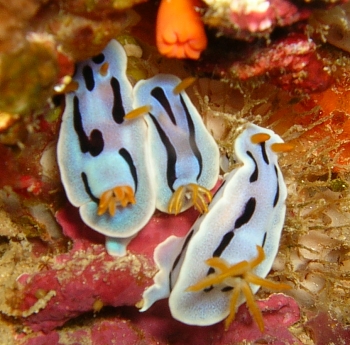
Dear Bill,
I can't decide whether this is Chromodoris lochi or Chromodoris dianae. Although the gills seem to have one color, the blue mantle shows white specks. Can you help me with this please?
The first picture was taken at Lekuan 2, the other two at the divespot Tanjung Parigi, both in Bunaken.
Locality: Bunaken, North Sulawesi, Indonesia, 03 October 2006, coral wall. Photographer: Geert Prast.
Thanks,
Mirjam
mirjam.broos@planet.nl
Broos, M, 2007 (Jan 26) Chromodoris dianae from Nth Sulawesi. [Message in] Sea Slug Forum. Australian Museum, Sydney. Available from http://www.seaslugforum.net/find/19117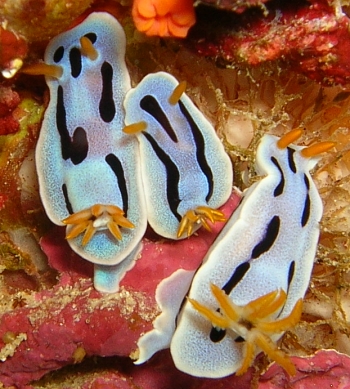
Dear Mirjam,
These are on eof the colour forms of C. dianae. The lower two photos are a good example of the difficulties involved in finding the food sponge of these animals. When you find a group of them clustered like this, all facing the same way you can be preety sure that food rather than sex has drawn them together. However, as often is the case, the substrate is overgrown with algal encrustations, sponges, bryozoan or hyroid colonies etc, and so there is no way from the phtos to know just what they are interested in, let alone identify it
Best wishes,
Bill Rudman
Chromodoris dianae from Sipadan, Malaysia
June 14, 2006
From: Charles Rowe
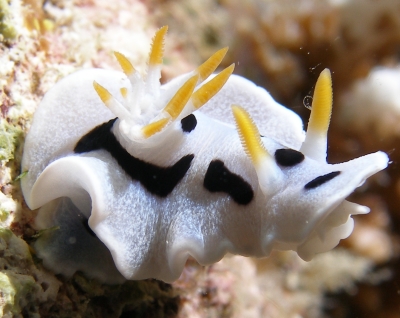
Hi Bill,
This is the second of a series of nudis from my trip to Sipadan which I would like you to identify and comment on.
Locality: Sipadan Island, 18 metres, Malaysia, 27 April 2006, Sandy bottom. Length: 1.5 inches. Photographer: Charles Rowe.
Charles Rowe
bumff@mweb.co.za
Rowe, C., 2006 (Jun 14) Chromodoris dianae from Sipadan, Malaysia. [Message in] Sea Slug Forum. Australian Museum, Sydney. Available from http://www.seaslugforum.net/find/16836Dear Charles,
This is Chromodoris dianae
Best wishes,
Bill Rudman
Re: Another C. lochi variation? from Philippines
April 12, 2006
From: Isidro Cuallado
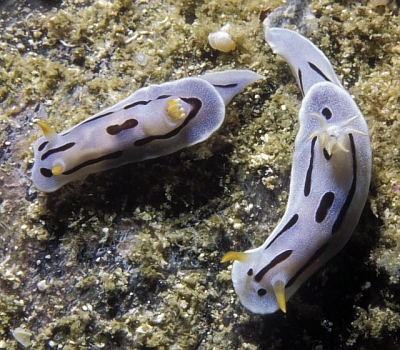
Concerning message #8098:
Dear Dr. Rudman,
I suspect this picture corresponds to a Chromodoris lochi, although the gills do not seem plain orange. Could you confirm the ID or may be it is a C. dianae or other species?
Locality: Moalboal, Cebu, unsure, may be 15 meters, Philippines, Western Pacific, 22 January 2004, Inshore, coral reef. Length: About 20 mm. Photographer: Isidro Cuallado.
Regards,
Isidro Cuallado
isidro@cuallado.org
Cuallado, I, 2006 (Apr 12) Re: Another C. lochi variation? from Philippines. [Message in] Sea Slug Forum. Australian Museum, Sydney. Available from http://www.seaslugforum.net/find/16290Dear Isidro,
These animals are confusing. I see in the message you refer to that Marli Wakeling wondered whether her C. lochi was C. dianae. In your case it is the reverse - the animal, which you suspect is C. lochi is in fact C. dianae. I expressed my doubts about the identification of this colour form as Chromodoris dianae some time ago but the authors of that species, Terry Gosliner and Dave Behrens, have assured us that it is a very variable species [see message #1436 ]
Best wishes,
Bill Rudman
Chromodoris dianae - feeding
April 10, 2006
From: Guido & Philippe Poppe
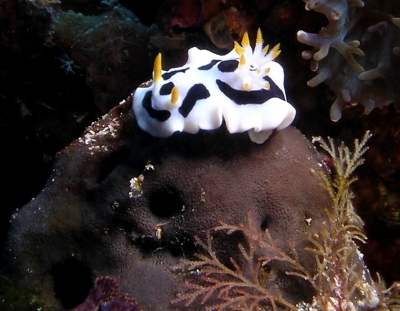
Dear Bill
Here are some photos of Chromodoris dianae you may find interesting from our website on Philippines marine life at
http://www.poppe-images.com/.
Photos: Hilutungan Island, nr Mactan Is, Cebu, Philippines. 32 m. 2005. Photos: Copyright Guido & Philippe Poppe.
Best wishes,
Guido & Philippe Poppe
philippe@conchology.be
Poppe, G. & Poppe, P., 2006 (Apr 10) Chromodoris dianae - feeding. [Message in] Sea Slug Forum. Australian Museum, Sydney. Available from http://www.seaslugforum.net/find/16255
Dear Guido & Philippe,
Thanks for these photos of C. dianae. I am pretty sure it is on a hard rock-like sponge Petrosaspongia. I wouldn't be surprised if the 'petro' in its name came from the Latin word for rock.
Best wishes,
Bill Rudman
Chromodoris dianae feeding?
November 12, 2005
From: Roberto Sozzani
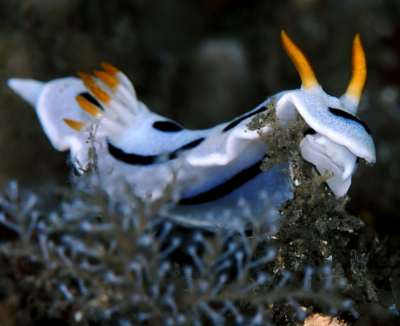
Dear Bill,
I found this photo of a Chromodoris dianae feeding on something that is not a sponge.
Locality: Gangga Is. Indonesia. Depth: 12 metres. Length: 4 cm. August 2004. muddy slope. Photographer: Roberto Sozzani
I hope this can be helpful for the Forum.
Best wishes
Roberto Sozzani
www.robertosozzani.it
roberto.sozzani@fastwebnet.it
Sozzani, R., 2005 (Nov 12) Chromodoris dianae feeding?. [Message in] Sea Slug Forum. Australian Museum, Sydney. Available from http://www.seaslugforum.net/find/15230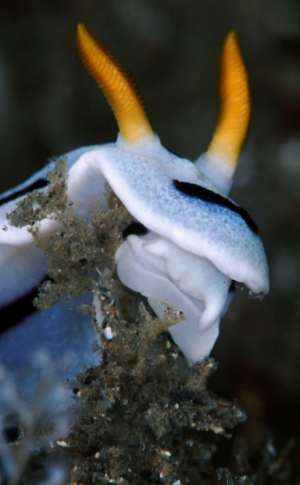
Dear Roberto,
Although I like new discoveries, I would have found a chromodorid feeding on something other than sponges to be a disturbing concept. However looking at your photo close-up I am sure the chromodorid is not feeding on the branching object it is on. I suspect the object is a dead part of the hydroid colony which fills the bottom half of the upper photo. If you look at the head, in the close-up, the mouth is visible between the two pointed oral tentacles and there is no sign of eversion of the buccal bulb or oral tube. The white piece in contact with the dead hydroid branch is thw anterior part of the foot.
Best wishes,
Bill Rudman
Re: Chromodoris dianae feeding
February 18, 2004
From: Roberto Sozzani
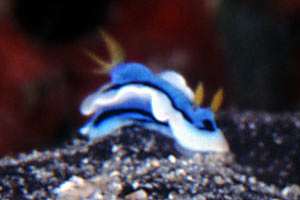
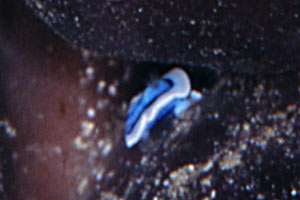
Dear Bill,
I checked again the first photo I sent you [message #12000], about Chromodoris dianae feeding on sponge and found a C. annae (upper left corner of original photo) lacking the orange/yellow border of the mantle [upper photo in this message], as you noticed in your message #12040, plus what seems a C. lochi (center of original photo). I send enlargements of both of them, even if not too clear.
If correct, we can see, in this single photo, 5 C. dianae, 1 C. annae and 1 C. lochi on the same sponge.
Best regards
Roberto Sozzani
roberto.sozzani@fastwebnet.it
Sozzani, R., 2004 (Feb 18) Re: Chromodoris dianae feeding. [Message in] Sea Slug Forum. Australian Museum, Sydney. Available from http://www.seaslugforum.net/find/12067Thanks Roberto,
Bill Rudman
Re: Chromodoris dianae feeding
January 29, 2004
From: Roberto Sozzani
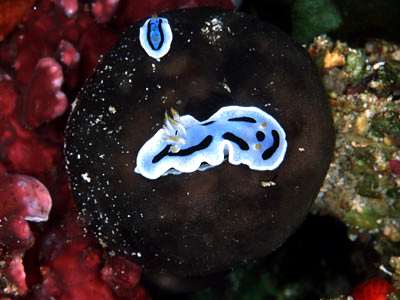
Dear Bill,
Again a Chromodoris dianae on a sponge, the small and almost round one. I send this photo because in the background there is another Chromodoris, which doesn't seem C. dianae to me.
Unfortunately, being in the background, is not clear and is out of focus, but I hope you can understand which species is sharing the same sponge which, in November and December 2003, was the favourite one by C. dianae, along the walls of Bunaken (Indonesia). Depth about 15 meters.
Best regards
Roberto Sozzani
roberto.sozzani@fastwebnet.it
Sozzani, R., 2004 (Jan 29) Re: Chromodoris dianae feeding. [Message in] Sea Slug Forum. Australian Museum, Sydney. Available from http://www.seaslugforum.net/find/12039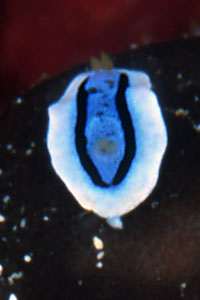
Thanks Roberto,
I'm afraid some of these juvenile, or at least small, individuals are difficult to identify. This could be C. annae or even C. elisabethina or something else. I'm afraid any identification would be just a guess
Best wishes
Bill Rudman
Re: Chromodoris dianae feeding
January 23, 2004
From: Roberto Sozzani
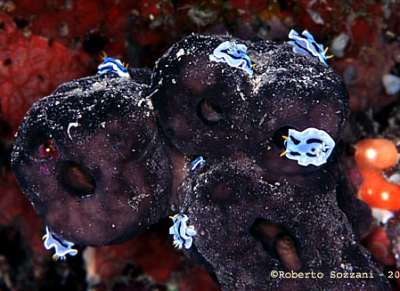
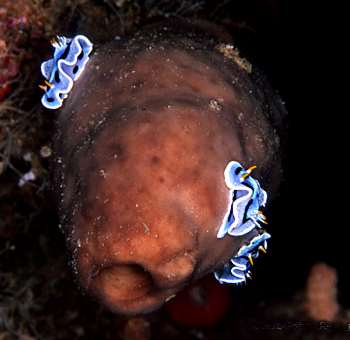
Dear Bill,
Concerning messages #11903 and #11985. I've seen many Chromodoris dianae on these kind of sponges (or similar?) last November and December, in Bunaken. Very often these sponges are well sheltered, in small caves, with very few light. I've seen many juvenile C. dianae on the same sponges, but too far inside into these caves for a good photo.
As you can see on the third photo, also C. willani likes the same sponge. I've other photos of C. willani on this sponge.
Bunaken (Manado) - North Sulawesi, Indonesia., November - December 2003., Depth: from 15 to 30 meters., Water Temp: 29C.
Best regards
Roberto Sozzani
roberto.sozzani@fastwebnet.it
Sozzani, R., 2004 (Jan 23) Re: Chromodoris dianae feeding. [Message in] Sea Slug Forum. Australian Museum, Sydney. Available from http://www.seaslugforum.net/find/12000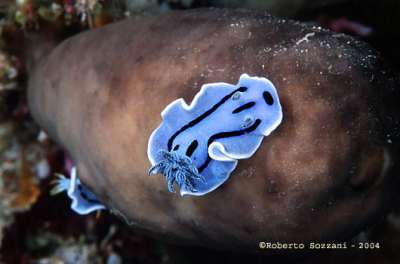
Thanks Roberto,
It is good to get more photos both to confirm its choice of diet and to give us a fuller picture of the shape and variability of the sponge[s]. I have posted a copy of your C. willani information in a separate message for cross-reference.
Best wishes
Bill Rudman
Chromodoris dianae feeding
January 22, 2004
From: Fredy Brauchli
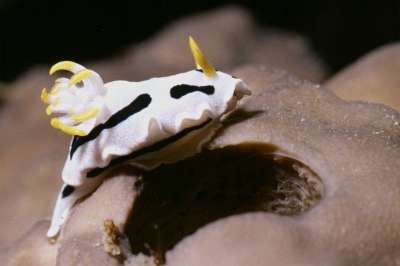
Hi Bill,
On Mary Jane Adams' photos of January 15, 2004, you've gotten an information on the preferred brown sponge of Chromodoris dianae.
I took a similar picture at Sipadan Island, Malaysian Borneo, in July 1997. The animal is also sitting on a brown sponge and feeding. I wonder if the little 'cave' is the the animals work.
Best wishes,
Fredy
brauchli@subaqua.ch
Brauchli, F., 2004 (Jan 22) Chromodoris dianae feeding. [Message in] Sea Slug Forum. Australian Museum, Sydney. Available from http://www.seaslugforum.net/find/11985Thanks Fredy,
This is a valuable confirmation of its food preference. The hole is a natural part of the sponge's shape.
Best wishes
Bill Rudman
Chromodoris dianae feeding
January 15, 2004
From: Mary Jane Adams
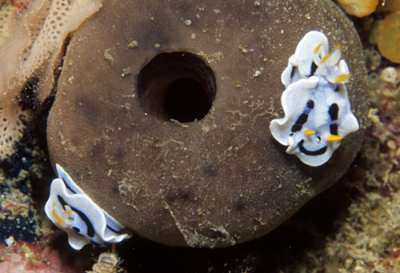
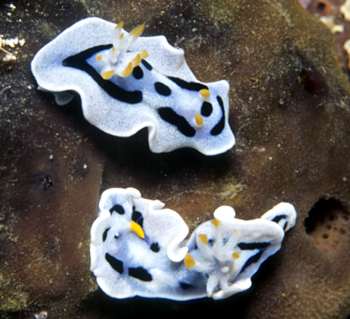
Hi Bill,
Chromodoris dianae was one of the most common nudibranchs I saw on my recent dive trip to the Sipadan-Mabul-Kapalai region of eastern Sabah, Malaysian Borneo. They did not vary much in color pattern. The ones I saw all looked like those in the attached images. When they weren't crawling, they were sitting on dark brown sponges about the size of an orange. I believe this is their prey.
Best regards,
Mary Jane
divepng@yahoo.com
Adams, M.J., 2004 (Jan 15) Chromodoris dianae feeding. [Message in] Sea Slug Forum. Australian Museum, Sydney. Available from http://www.seaslugforum.net/find/11903Thanks Mary Jane,
The sponge information is very useful and if we are lucky I should have it identified in a couple of weeks
Best wishes
Bill Rudman
Chromodoris dianae from Borneo.
September 6, 2003
From: Kheong Sann Chan
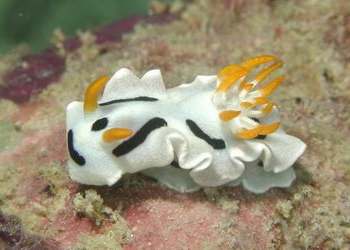
Dear Bill
Went on a recent trip to Mabul Island which is off the eastern coast of Borneo, eastern Malaysia. Nudis were quite plentiful under the seaventure oilrig at which we stayed.
Location: under seaventure oilrig
Date: 20 Aug 2003.
Depth: about 17m
locality: sandy flat bottom, corals. 6 huge pillars supporting the rig. metal structures strewn about the place.
Kheong.
kschan@mail.dsi.a-star.edu.sg
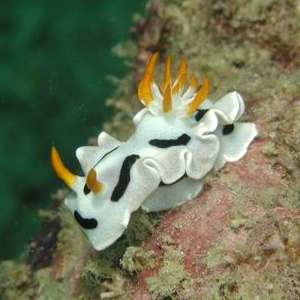
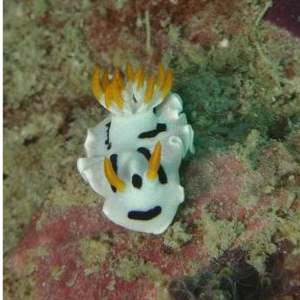
Dear Kheong,
This is one of the colour forms of Chromodoris dianae.
Best wishes,
Bill Rudman
Chromodoris dianae from Okinawa
March 4, 2003
From: Bob Bolland
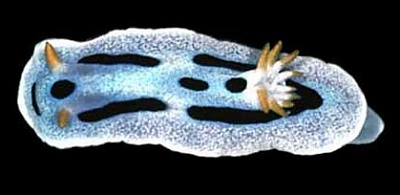
Hi Bill,
Here's an additional distributional record for Chromodoris dianae collected from Okinawa.
Data: Seragaki, Okinawa
TL: 37mm
9 Sept., 1992
Collected from 43m on 9 Sept., 1992
This is one of three specimens which I've collected here.
Cheers,
Bob
bollandr@rapid-link.ne.jp
Bolland, R., 2003 (Mar 4) Chromodoris dianae from Okinawa. [Message in] Sea Slug Forum. Australian Museum, Sydney. Available from http://www.seaslugforum.net/find/9228Thanks Bob,
Bill Rudman
Re: Chromodoris dianae
February 15, 2003
From: Mark Burnett
Hi Bill,
Sorry about the lack of details in my recent C. dianae message . This was from my trip to Mabul, Borneo, last October. It was taken at a dive site called Paradise 3 on the north side of Mabul. Depth was 12 metres and this individual was around 3 cm long.
Regards
Mark Burnett
mburnett@actrix.co.nz
Thanks Mark,
The reason I ask for some details is that a photo is only a photo - no matter how beautiful - until it has some data attached. Then it becomes a valuable bit of scientific information.
Cheers,
Bill Rudman
Chromodoris dianae
February 14, 2003
From: Mark Burnett
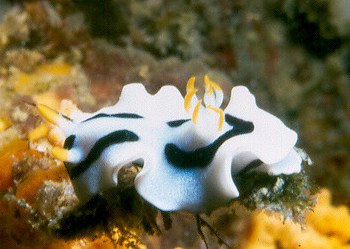
Hi Bill,
The Forum continues to impress. I had labelled the accompanying slide as Chromodoris lochi until I saw the message from Richard Houghton. I had based this ID on Debelius' book which shows two pictures on the C. lochi page. The right image is C. lochi but the left image is C. dianae which is not represented in the book. As you mention in your review page, this book has it's shortcomings though it has many superb photographs which aid in identifying nudibranchs when one is out of one's usual dive location.
Best regards,
Mark Burnett
mburnett@actrix.gen.nz
Burnett, M., 2003 (Feb 14) Chromodoris dianae. [Message in] Sea Slug Forum. Australian Museum, Sydney. Available from http://www.seaslugforum.net/find/9185Thanks Mark,
Can I have some locality information to go with the photo please. Is this from your trip to Mabul, Borneo, in October 2002?
Cheers,
Bill Rudman
Chromodoris dianae from Mabul Island, Malaysia
February 6, 2003
From: Richard Houghton
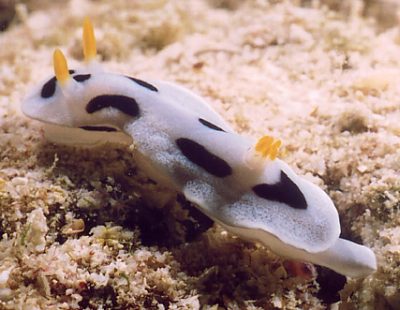
This moving nudibranch is possibly Chromodoris lochi. Mabul Island, Malaysia, August 2002.
It seemed to be sliding over the reef with a destination in mind, though it was not obvious what this might be.
Best regards,
Rich
richard_houghton@hotmail.com
Houghton, R., 2003 (Feb 6) Chromodoris dianae from Mabul Island, Malaysia. [Message in] Sea Slug Forum. Australian Museum, Sydney. Available from http://www.seaslugforum.net/find/7852Dear Rich,
They certainly do look like they are on a mission when they get moving. This is one of the colour forms of Chromodoris dianae. The yellow-tipped white gills and the granular look of the mantle, are two quite characteristic features.
Best wishes,
Bill Rudman
Chromodoris dianae from Philippines
December 19, 2002
From: Deanna Charlton-Jones
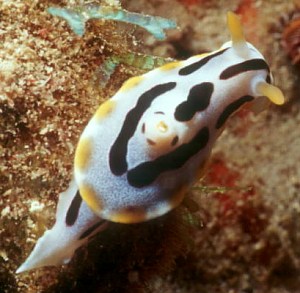
I found this at Puerta Gallera, Philippines September 2002. Depth: 14m, Size: 3cm
I've looked through loads of pics but I'm still not sure which family this belongs to. Any help appreciated.
Deanna Charlton-Jones
deannar@candw.ky
Charlton-Jones, D., 2002 (Dec 19) Chromodoris dianae from Philippines. [Message in] Sea Slug Forum. Australian Museum, Sydney. Available from http://www.seaslugforum.net/find/8671Dear Deanna,
This is one of the colour forms of Chromodoris dianae.
Best wishes,
Bill Rudman
Chromodoris dianae -flattened egg ribbon
December 6, 2002
From: Mary Jane Adams
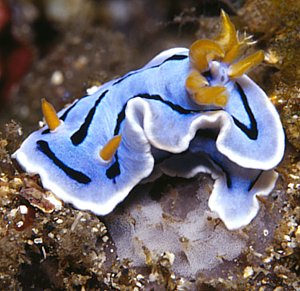
Hi Bill,
I found this Chromodoris dianae laying eggs in Lembeh Strait, Sulawesi, Indonesia. I am surprised to see that the egg ribbon is laying flat, not standing on edge as with most Chromodorids. I wonder if this is typical of this species or due to the rough substrate this slug has chosen to lay it's eggs.
Divesite: Nudi Retreat,
Depth: 10-15 meters,
Date: November 19, 2002.
Best regards,
Mary Jane
divepng@yahoo.com
Adams MJ., 2002 (Dec 6) Chromodoris dianae -flattened egg ribbon. [Message in] Sea Slug Forum. Australian Museum, Sydney. Available from http://www.seaslugforum.net/find/8594Dear Mary Jane,
Thanks for this very interesting observation. As Scott Johnson noted in an earlier message, the species of Chromodoris with longitudinal black lines, that we know about, lay these flattened egg ribbons. I think your photo is the first record of this species' egg ribbon so its a nice addition to the story.
Best wishes,
Bill Rudman
Chromodoris from the Moluccas
November 26, 2002
From: Ginette Allard
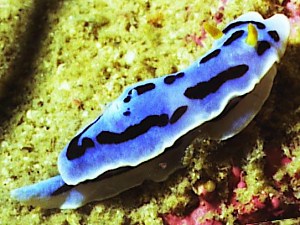
This Chromodoris is from the Moluccas [Indonesia] in July 1998. Is it Chromodoris lochi? The dark lines are not lines but spots.
Thank you for your help,
Ginette Allard.
gigiallard@aol.com
Allard, G., 2002 (Nov 26) Chromodoris from the Moluccas. [Message in] Sea Slug Forum. Australian Museum, Sydney. Available from http://www.seaslugforum.net/find/8465Dear Ginette,
This is similar to photos from Sulawesi message 1, message 2, which I am tentatively indentifying it as Chromodoris dianae. The blue background is more uniform so I am not totally happy with this identification
Best wishes,
Bill Rudman
Chromodoris dianae from Sulawesi
July 6, 2002
From: Mary Jane Adams
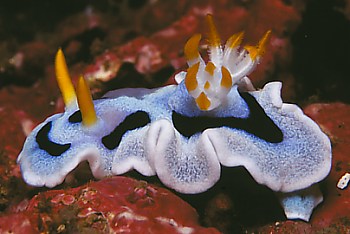
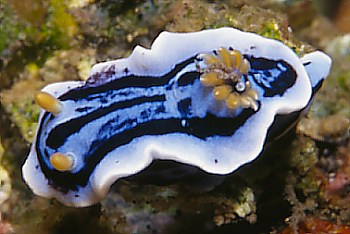
Hi Bill,
Here are a couple of candidates for the Chromodoris dianae. I shot the upper one at Angel's Window, a coral reef on Lembeh Island on August 9, 2001. It was about 25mm long. The lower one is from Magic Rock, a sand slope with patch reef on the Sulawesi side of Lembeh Strait, Aug. 10, 2001. It was 15mm long. The two divesites are about 8km apart. Are both of these C. dianae?
Best regards,
Mary Jane
divepng@yahoo.com
Adams, M J., 2002 (Jul 6) Chromodoris dianae from Sulawesi. [Message in] Sea Slug Forum. Australian Museum, Sydney. Available from http://www.seaslugforum.net/find/6913Dear Mary Jane,
The upper photo clearly fits the original description of C. dianae but the lower one looks like an aberrant Chromdoris lochi. Some animals get this distinctive bluish tinge but the extra black smudges and the white gill tips are unusual.
Cheers,
Bill Rudman
Nudibranch from Sulawesi
June 14, 2002
From: Barbara Phua
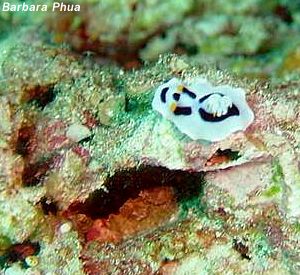
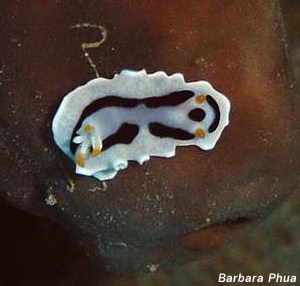
Hi Dr Rudman,
I saw this nudibranch in the waters of Sulawesi, Indonesia. I've searched through some books but couldn't find an ID for it.
Could you please help?
Barbara Phua
babala.pan@pacific.net.sg
Phua, B., 2002 (Jun 14) Nudibranch from Sulawesi. [Message in] Sea Slug Forum. Australian Museum, Sydney. Available from http://www.seaslugforum.net/find/7194Dear Barbara,
This is Chromodoris dianae
Best wishes,
Bill Rudman
Chromodoris dianae from Bali
March 23, 2002
From: Stuart Hutchison
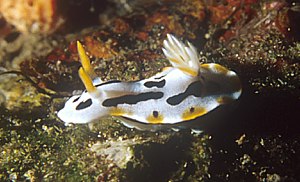
Hi Bill,
This is a pretty average photo, but I hoped you can identify the species for Melinda and I. It was found at 20m or so in Bali, Indonesia on 21 Oct 2001. Length was about 50mm.
Regards,
Stuart
stuart@stuarthutchison.com.au
Hutchison, S., 2002 (Mar 23) Chromodoris dianae from Bali. [Message in] Sea Slug Forum. Australian Museum, Sydney. Available from http://www.seaslugforum.net/find/6294Dear Stuart,
This is one of the colour forms of Chromodoris dianae.
Cheers,
Bill Rudman
Variation? in Chromodoris dianae
June 25, 2001
From: Bernard Picton
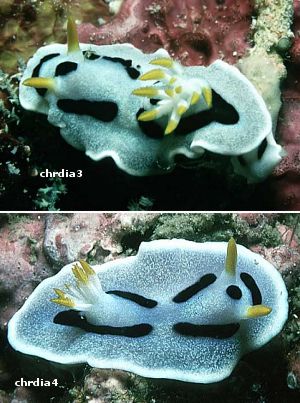
Hi Bill,
These Chromodoris dianae are a small selection of the ones I have seen over the years. I have my doubts as to whether it is one variable species. While the gills in 'true' C. dianae are variable in colour and the orange pigment spots at the edge of the mantle develop from nowhere in slightly larger individuals, the form with white gill bases abruptly changing to yellow tips seems different. There are other features which distinguish it from C dianae in my opinion. I'll call it C. cf. dianae in this message for clarity. In C. cf. dianae the whitish pigment all over the mantle is not areolate as it is in C. dianae and has a different 'consistency'. There is normally a black curved line across the front of the head and a circular black spot between the rhinophores, whilst in C. dianae there is a line of black spots which develop in the midline of the back and between the rhinophores - predominantly longitudinal rather than the transverse sort of marking in C. cf. dianae. C. cf. dianae also seems to be a broader animal even given the way nudibranchs change shape as they move.
I've re-read Dave and Terry's paper and I still think there are two entities here as you suggested in an earlier message. (I don't agree completely with the way you divided Lindsay's pictures! Only the first one from Hoga is definitely C. cf. dianae by my criteria and is probably the same individual as my chrdia3. This is a tricky problem, is anyone looking at DNA or enzymes?
My pictures as follows -
chrdia - Hoga, Indonesia, 1997
chrdia1 - Hoga, Indonesia, 1997
chrdia2 - Sipadan, Malaysia - 1992
chrdia3 - Hoga, Indonesia, 1997 - C. cf. dianae
chrdia4 - Bali - 1996 - C. cf. dianae
chrdia5 - Sipadan, Malaysia - 1992
chrdia6 - Philippines, 1983
Bernard
bernard.picton.um@nics.gov.uk
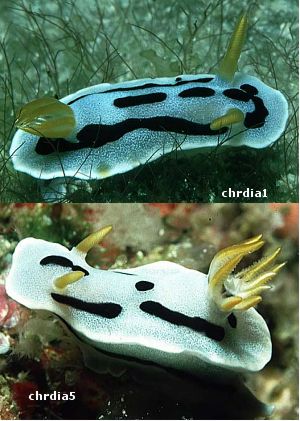
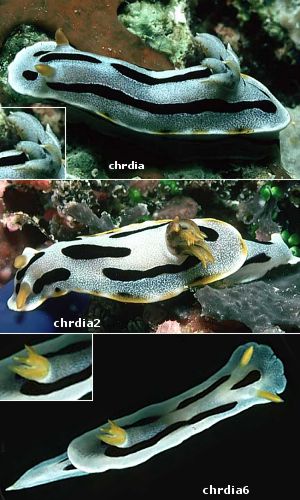
Thanks Bernard,
There's nothing like a good taxonomic tangle to stir the blood! Two questions arise if it turns out that there is more than one species. The first is: Which is the real C. dianae? - there is nothing in the original description to identify the colour form of the holotype. The second question is that if the variable form (not the yellow-tipped gill form) is the 'real' C. dianae, then how does it differ from some of the colour forms of Chromodoris michaeli in yesterday's message?
Best wishes,
Bill Rudman.
Chromodoris michaeli? from the Philippines
June 17, 2001
From: Erwin Köhler
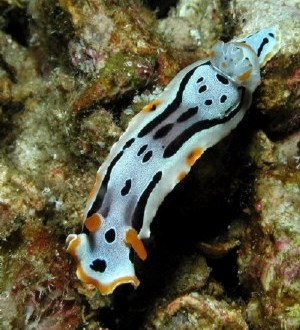
Dear Bill,
Here is the next one from the Philippines, Cebu Island, Moalboal, divesite "Pescador", depth 42 m, length 54mm, May 27, 2001.
Is it Chromodoris michaeli?
Erwin
Erwin@medslugs.de
Dear Erwin,
The black markings in your photo are similar to the photo of C. michaeli in the original description but that species is described with a continuous orange mantle border and with gills that are translucent orange.
Although your animal has a continuous orange border around the anterior end of the mantle, in all other respects it is identical to the colour form of C. dianae which has the orange line along the outside of each gill.
Best wishes,
Bill Rudman
Colour forms of Chromodoris dianae
October 18, 1999
From: D. Behrens & T. Gosliner

Hi Bill:
In your April 8, 1998 message to Lindsey Warren, you commented that you were
uncertain about that the color variants that we described for Chromodoris dianae were all the same species. We still have not been able to find any anatomical differences between them and the colors do seem to intergrade. Attached is a photo taken by Jeff Rosenfeld from Batangas, Philippines, this April. In the photo you can see the two morphs, and that they seem to be more than casually interested in each other. This suggests that they at least think they are the same species.
Cheers,
Dave Behrens & Terry Gosliner
California Academy of Sciences
San Francisco, California
david@seachallengers.com
Behrens, D. & Gosliner, T., 1999 (Oct 18) Colour forms of Chromodoris dianae. [Message in] Sea Slug Forum. Australian Museum, Sydney. Available from http://www.seaslugforum.net/find/1436Dear Dave & Terry,
Thanks for the photo. I'm glad to see comments and messages are not being forgotten. I'm still amazed at how variable the gill colour is. In most chromodorids it has been a nice consistent character to use. Now we seem to have a species which in Jeff Rosenfeld's photo can either be entirely yellow, whitish with an external yellow line, or in Ho Soon Lin's photo at the top of the page, white with yellow tips. I hope there aren't too many species with such a variability.
Bill Rudman.
More Chromodoris dianae from Sulawesi
December 19, 1998
From: Lindsay Warren
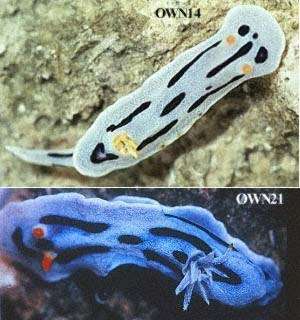
Subject: More Chromodorids from the Tukang Besi, Sulawesi, Indonesia.
Dear Bill
Many thanks for posting details of Discodoris? liturata as well as the replies on the others. I have a few more chromodorid queries to clear the backlog from earlier this year and then I will be able to send through more recent finds. Please find attached:
OWN14 - probable Ch. dianae, Length 3cm, found at a depth of 14.2m on red encrusting coralline algae. Some gills had black markings on the inside towards the base. Photo: Jane Marshall.
OWN17 - probable Ch dianae. Length: 3.8cm, found at a depth of 14.3m. Looked as if it had been feeding on very small hydroids growing on Polycarpa pigmentata or on the tunicate itself although this was felt to be doubtful as it was heavily covered with algae and other lifeforms. Mantle and body very mottled with white - under the microscope the white specks were found to be raised. Photo: Adam Powell.
OWN21 - probable Ch dianae. Length: 3.2 cm. Found at a depth of 5m on a wall crawling on coralline algae. Only four tips of gill filaments were slightly orange and this could only be seen under the microscope. There were also some black dashes on the outside of the gills.
OWN36 - ? possible Ch dianae. Length: 3.5 cm. Found at depth of 22m on olive green soft moss-like sponge in strong current. Orange retractile lamellate rhinophores.
OWN43 - ? possible Ch dianae. Length: 3 cm. Found at 12 m on macro algae. Orange retractile lamellate rhinophores. Photo: Adam Powell.
I now have details of shots sent through previously:
OWN02 - Chromodoris strigata - 1.3 cm
OWN10/1 -Chromodoris annae - 1.5 cm
OWN18 - Chromodoris dianae - 3 cm
OWN22 - Chromodoris elizabethina - 25 mm
If you would like any other details, please let me know and hopefully I will have this on the data sheets.
Many thanks for all your help.
With best wishes
Lindsay Warren
100014.2112@compuserve.com
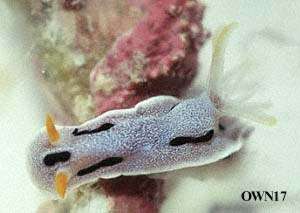
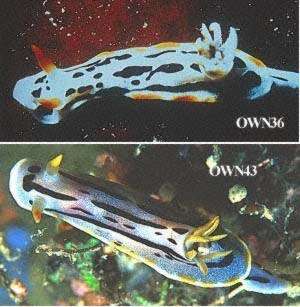
Dear Lindsay,
Thanks for the pics. All the above fit Gosliner & Behren's description of Chromodoris dianae. Two of them (OWN14, OWN21) are the colour form with yellow-tipped gills, and the other three (OWN17, OWN36, OWN43) are the form with the yellow-lined gills.
Your mention of OWN17 feeding on hydroids or the ascidian is unlikely as all other chromodorids we know the food of, are sponge feeders.
Thanks for the other information. I have put it with the relevant message.
Best wishes
Bill Rudman.
Chromodoris dianae from Sulawesi
November 19, 1998
From: Lindsay Warren
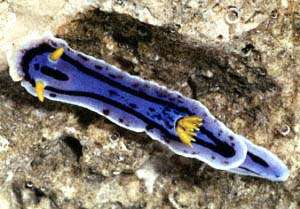
Dear Bill
Have just returned from three months once again working with Operation Wallacea on Pulau Hoga in the Tukang Besi Islands off SE Sulawesi, Indonesia.
Could you help us identify this photo? The animal is overall pale blue / grey base, brilliant white edge to mantle, black lines and patches with orange rhinophores and gills. Length: 3 cm
We have found many specimens with varying colour patterns which seem related to either Ch. annae or C. elisabethina and I will forward these to you as soon as they have been scanned in.
Many thanks for your help,
Lindsay Warren
75 Netherwood Road,
London W14 0BP
100014.2112@compuserve.com
Warren, L., 1998 (Nov 19) Chromodoris dianae from Sulawesi. [Message in] Sea Slug Forum. Australian Museum, Sydney. Available from http://www.seaslugforum.net/find/319Dear Lindsay,
This falls within the colour range of Chromodoris dianae. This colour form is the one with orange down the length of the gills. There is a faint trace of orange around the anterior margin of the mantle. It is like the bottom animal in your April 22 message.
best wishes,
Bill Rudman.
Re: Found in Indonesia
April 22, 1998
From: Lindsay Warren
Dear Bill
Many thanks for the answers to the queries on the batch of four nudibranchs which you have posted up on the Slug Forum. Must confess that I was a little puzzled about the two Chromodoris both being dianae as they had some distinct differences. I was also interested to see the one classified as magnifica as this too I had not seen anywhere else with these kind of markings.
Many thanks for your help.
All the best
Lindsay Warren
100014.2112@compuserve.com
Warren, L., 1998 (Apr 22) Re: Found in Indonesia. [Message in] Sea Slug Forum. Australian Museum, Sydney. Available from http://www.seaslugforum.net/find/42Found in Indonesia
April 8, 1998
From: Lindsay Warren
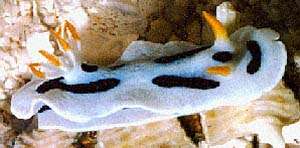

Dear Bill
I have attached some jpg files which I hope you can identify. As with the others they were found around Pulau Hoga in the Tukang Besi islands of SE Sulawesi, Indonesia last September when Bernard Picton was also there. Most of the diving was on walls as previously described heavily covered in hard and soft corals, ascidians, coralline algae and small areas of green / brown algae with depths between 3-20m. Unfortunately I do not have the notes of exactly what surface they were each found on.
Many thanks for your help
All the best
Lindsay Warren
100014.2112@compuserve.com
Warren, L., 1998 (Apr 8) Found in Indonesia. [Message in] Sea Slug Forum. Australian Museum, Sydney. Available from http://www.seaslugforum.net/find/43Both these photos are identifiable with Chromodoris dianae. This species has only recently been named. It is one of a number of white or bluish chromodorids with black longitudinal lines and orange or yellow on the gills, rhinophores and sometimes the mantle edge. I am not sure whether Gosliner & Behrens have the story completely correct as they include animals which fit both your photos. One colour type has yellow-tipped gills (as in the photo above from Cebu) and the other has a yellow line along the outer edge of each gill. In other groups of similarly coloured chromodorids such differences often correlate with anatomical differences...Bill Rudman
Rudman, W.B., 1998 (Apr 8). Comment on Found in Indonesia by Lindsay Warren. [Message in] Sea Slug Forum. Australian Museum, Sydney. Available from http://www.seaslugforum.net/find/43